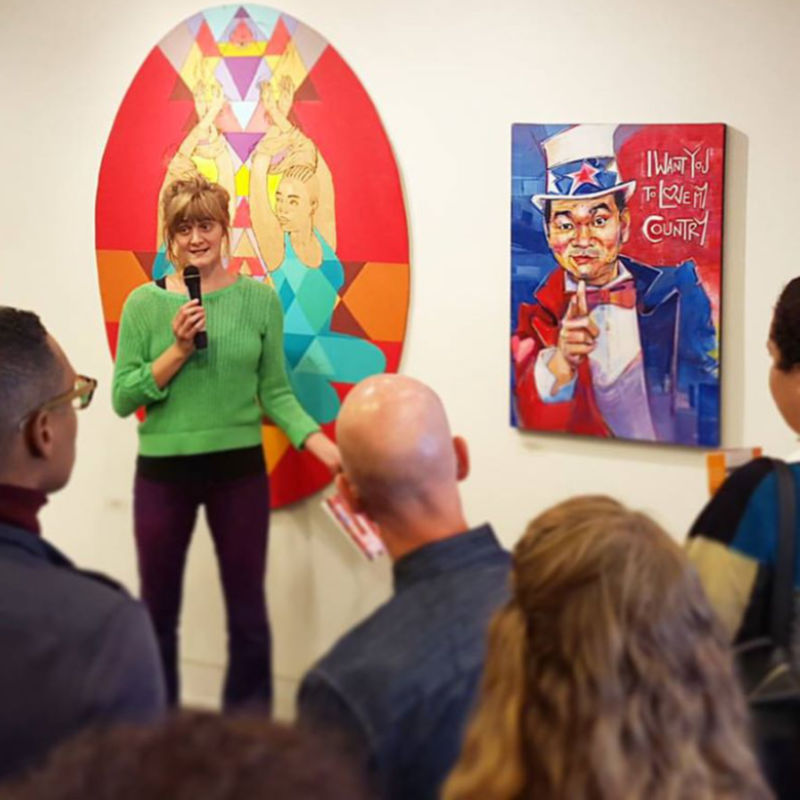Blog / 2015 / How to Love Your Art (and Yourself)
June 18, 2015
Making art and putting it into the world is a vulnerable process which often leaves artists feeling raw, fragile, and not particularly chatty, but, as artists today, we don’t get to withdraw. Whether we like it or not, we’re an integral part of the interest in our work, and, in order for our art to be appreciated, we need to be truly present in its presentation. Here are six ways to do just that:
- Figure out how to enjoy talking about your work, and do it regularly.
- Establish good boundaries for sharing.
- Exhibit grace in the face of press.
- Show up for your art.
- Step back from promotion when you need to, but do it consciously.
- Take a break from art-making every so often.
Some artists love to blog, but too often creatives force themselves into this model even though it’s not a good fit for their personality. Many would probably do better with shorter and less formal posts about their work directly on social media.
Then again, maybe you’re happier talking than you are writing, so vlogging is the direction you should take. Or maybe all the online chatter just makes you cringe. In that case, you can keep it to a minimum by holding plenty of in-person events with your work. You could even invite specific people to your studio—friends as well as potential business contacts—on a monthly basis.
Whatever you do, the important thing is to keep the conversation about your art going. These exchanges will help you figure out what your art is really about and they’ll keep your work on people’s minds.
While you’re doing all this talking, you might slip up and reveal something you wish you hadn’t. We’ve all done it and we’ll probably keep doing it now and again. It’s how we learn where our public/private line is. That line is in a different place for each individual and it almost certainly shifts over the course of an artist’s career, but it’s important to know something about yours so that you can love your art properly without making yourself too vulnerable.
Artists are universally bad at being written about. If you can be even a little less irritated and obnoxious in your reaction to press about your art, you’ll be way ahead of the game.
I happen to know this particular part of the artist love equation from both ends. I’ve been the cranky artist who doesn’t appreciate the way she’s been represented, and I’ve also suffered the crankiness of artists I’ve written about. In my experience, when I don’t interview artists but simply write about their work, they often feel I should have given them a say, but, when I contact artists for an interview, at least half the time they don’t even acknowledge my query.
All of which is to say, that art writers and journalists are artists too. More specifically, they are portraitists. Some of them are better than others—some of them are more sensitive to their subject and they care more about creating an accurate portrait—but they’re all depicting you and your work from their unique perspective. And while it’s never easy to see yourself as others see you, it is always educational.
It’s deeply disappointing to come to an opening or some other event featuring an artist’s work and discover that the artist has decided not to attend. Even if I don’t talk to a creative, I like to observe them with their work. When they don’t bother to show, it always leaves me making up stories for why, and, however empathetic I try to be, those stories are never particularly flattering.
And, for the record, it is absolutely better to be there and be awkward than to not show up at all. I know this because I can definitely be awkward! Pro tip: when people compliment your art, just say “thank you” and then ask them about themselves.
Artists can and should tuck themselves away in their studio now and again. There’s no art career without art, and, if hiding in your hovel is what allows you to create, then by all means hide yourself away. That said, there’s also no art career—no appreciation of your art—without marketing.
Don’t just drop your blog for eight months and call it “creative time” later. Be aware of the time you take away from promotion and really working the business end of things. The good news is that, once you find a marketing outlet that flows with who you are, it’ll be easier to stick with it and only take time away when it’s really necessary.
It helps me to think of my creativity in terms of input and output. My output is prolific, but only because I allow myself a lot of input. That includes reading and enjoying other people’s work, but also getting out of the studio to be with friends and family. Those relationships feed me on many of levels.
And I take time off in bigger ways as well. For example, in 2012 I made close to seventy paintings, and in 2013 I created just thirteen, reducing my output consciously as a part of a bargain I made with myself. You see, in 2012, my endometriosis suddenly required another surgery, and, despite my body’s objections, I pushed through my illness to finish a large collection of work by November of that year. Part of how I did this was to promise myself a laid back 2013.
Two years later, I’m still grateful that I gave myself that time when I needed it. Without a 2013 dedicated mostly to input, I never would have been strong enough for everything 2014 sent my way (the good, the bad, and the wonderful) and I wouldn’t have had the energy for 2015’s output either.

Both making art and sharing it are vulnerable, and I, for one, would often much rather stay safely nestled in my art space. But I’d be lying if I said I never want to be out in the world, promoting my art and learning from those who interact with it.
Art is a social activity. I may feel a bit drained after doing an artist talk at a gallery, but it’s just as true that the time spent with art lovers replenishes me. The fact is that this sort of interaction is ultimately what allows me to keep on making art.
For more about promoting your art and how to enjoy it, check out my e-book Art Marketing or hire me as an art guide.
UPDATE
May 16, 2020
To celebrate my 17th artiversary, I expanded on this article with seventeen tips for how to love your art!
Maybe this post made you think of something you want to share with me? Or perhaps you have a question about my art? I’d love to hear from you!
To receive an email every time I publish a new article or video, sign up for my special mailing list.
If you enjoyed this post, Ko-fi allows you to donate. Every dollar you give is worth a bajillion to me!



